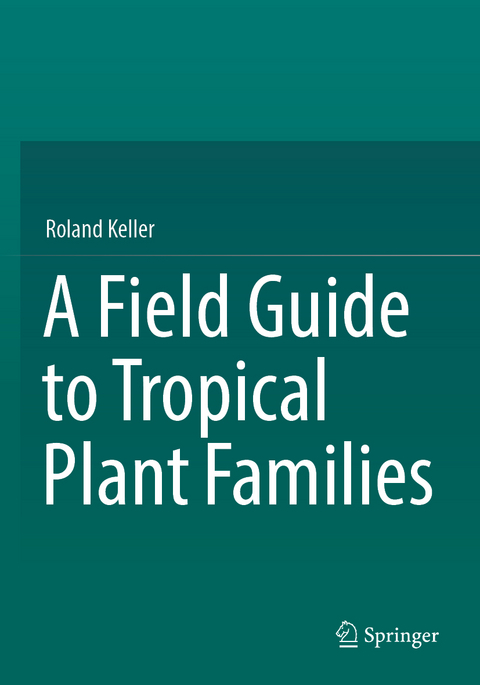
A Field Guide to Tropical Plant Families
Springer International Publishing (Verlag)
978-3-031-05944-5 (ISBN)
This book provides an identification system permitting recognition of plant families in all seasons by means of morphological and macroanatomical features which are easily observable, such as bark, exudates, stems and leaves characters. Studies of forest vegetation may differ in their underlying objectives, but they all require taxonomic knowledge. The process of taxonomy begins with an inventory of the flora, which has been based to a large extent on reproduction-related organs, such as flowers and fruits. But, those are often difficult to observe and may not exist in the field at a given time.
Unlike most such guides or keys, this book can be used anywhere in the tropics and provides, in a straightforward two or three-step process, identification to the level of families, which are now circumscribed according to molecular as well as morphological characters in the universally accepted scheme of the Angiosperm Phylogeny Group.
Plant architecture is not a prerequisite theme for plant identification; however, we think that an introduction to this subject is not out of place in this book (architectural traits are taxonomically sound): it is now time for botanists working in the tropics to have an idea on how the whole organism keeps growing.
Within the family accounts, there is information concerning important economic plants with notes on the larger genera and, particularly helpfully, discussion of families readily confused and how to separate them. Descriptions of the families rely on short diagnosis bolstered by many photographic pictures, lines drawings and extracts from the author's field books, all showing features of plants as they are found in the forest.
Roland Keller is an independent botanist living in Switzerland. He was trained in the "Montpellier School "of botanists, where he was initiated into the fields of plant architecture and botanical illustration, aspects which have remained important throughout his career.
He has worked as a Research Associate at the Institute of Systematic Botany and Geobotany of the University of Lausanne and has carried out most of his fieldwork in the tropical forests of numerous countries, as well as in alpine areas. He has also been involved with surveys of biodiversity in Switzerland.
This book is a completely revised version of his previous field guide : Identification of Tropical Woody Plants in the Absence of Flowers, which was published almost 20 years ago.
Part I - User manual and architectural concepts. Chapter 1. Introduction.- Chapter 2. How to use this book 6.- Chapter 3. Architectural concepts and key to the models.- Part II. Identification keys.- Chapter 4. Key to the groups of families of trees and shrubs (groups 1 to 52).- Chapter 5. Keys to families of trees and shrubs.- Chapter 6. Supplementary keys.- Chapter 7. Keys to the groups of families of lianas and woody epiphytic (groups 53 to 57).- Chapter 8. Keys to families of lianas and woody epiphytes.- PART III. Description of the families.- Chapter 9. Acanthaceae to Asteraceae.- Chapter 10. Bignoniaceae to Buxaceae.- Chapter 11. Cactaceae to Cycadaceae.- Chapter 12. Dichapetalaceae to Dipterocarpaceae.- Chapter 13. Ebenaceae to Euphorbiaceae.- Chapter 14. Fagaceae.- Chapter 15. Gentianaceae to Goupiaceae.- Chapter 16. Hamamelidaceae to Humiriaceae.- Chapter 17. Icacinaceae s.l. to Irvingiaceae.- Chapter 18. Juglandaceae.- Chapter 19. Lamiaceae to Lythraceae.- Chapter 20. Magnoliaceae to Myrtaceae.- Chapter 21. Nyctaginaceae,- Chapter 22. Ochnaceae to Oxalidaceae.- Chapter 23. Pandaceae to Putranjivaceae.- Chapter 24. Rhabdodendraceae to Rutaceae.- Chapter 25. Sabiaceae to Symplocaceae.- Chapter 26. Tetramelaceae to Torricelliaceae.- Chapter 27. Ulmaceae s.l. to Urticaceae.- Chapter 28. Verbenaceae to Vochysiaceae.- Chapter 29. Zygophyllaceae s.l.- Chapter 30. Herbaceous versus arborescent habit in the families and orders of flowering plants - evolutionary trends.
| Erscheinungsdatum | 11.02.2024 |
|---|---|
| Zusatzinfo | XVII, 494 p. 909 illus., 850 illus. in color. |
| Verlagsort | Cham |
| Sprache | englisch |
| Maße | 178 x 254 mm |
| Gewicht | 946 g |
| Themenwelt | Naturwissenschaften ► Biologie ► Botanik |
| Naturwissenschaften ► Biologie ► Ökologie / Naturschutz | |
| Schlagworte | Field guide • identification keys • lianas • plant families • Plant genera • Tropical plants • tropical trees • Vegetative characters |
| ISBN-10 | 3-031-05944-1 / 3031059441 |
| ISBN-13 | 978-3-031-05944-5 / 9783031059445 |
| Zustand | Neuware |
| Informationen gemäß Produktsicherheitsverordnung (GPSR) | |
| Haben Sie eine Frage zum Produkt? |
aus dem Bereich


